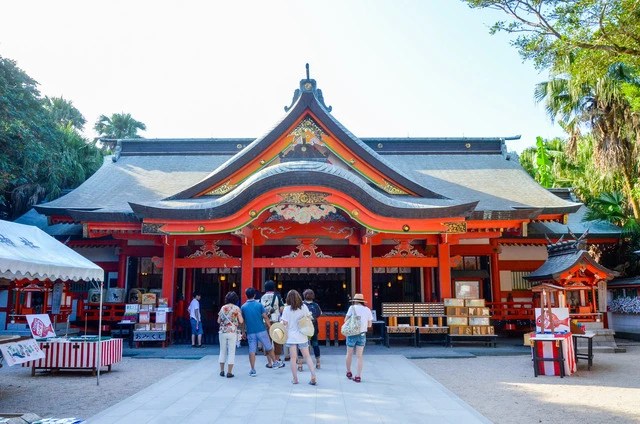Okay, I’ll admit it. I’ve been putting off making this post forever because it is going to be a LONG one! Most postcards on this blog are pretty easy to explain. They often represent a place like a shrine or temple, a food like fruit or vegetables, or a person famous from the area. However this particular postcard isn’t that easy because it takes a bit of background knowledge on Japanese history and legends to understand just who the guy on the postcard is, and why he was featured. But today, I’m rising to the challenge!
Let’s start at the beginning.
The oldest books in Japanese history are the Kojiki and the Nihon Shoki, in which the myths and legends of Japan are written. It is said that Izanagi and Izanami, after creating Japan (and I guess the rest of the world), created three children as well: Amaterasu, the goddess of the sun; Tsukuyomi, the god of the moon; and Susanoo, the ocean and storm god.
Amaterasu didn’t exactly get along with her siblings, but in her defense, Susanoo especially seems like he was a bratty little brother, even throwing a flayed horse at her while she sat quietly weaving. In a rage (and probably in defense as well), she hid herself in a cave, denying the world of her light. The other gods and goddesses were concerned as the earth began to die, but no amount of pleading could bring Amaterasu out from her cave. Finally, the goddess of laughter, Ama-no-Uzeme started dancing wildly, and the other gods and goddesses laughter finally brought the curious Amaterasu peaking out of her cave. The god of strength, Tajikara Onomikoto, took the giant rock used to block the cave, and threw it all the way to what is now Nagano Prefecture, where you can see it today somewhere near Zenkouji. (Look, that’s the legend okay, I just report it how it is).
So in Takachiho we’ve allegedly got the cave where Amaterasu hid herself, the cave where the other gods and goddesses met to discuss what to do, and the origin-place of a rock that is now in Nagano.

Tajikara Onomikoto’s statue in front of the Amano Iwato Shrine

A bit clearer of a picture

The ema of Amano Iwato Shrine showing Amaterasu emerging from the cave.
The Amano Iwato Shrine’s inner shrine is actually the cave where Amaterasu hid. You can ask the priests at the temple for a view of it, and they will explain the legend and take you to the look out area to spot the cave, but no pictures are allowed of the viewing platform or the cave itself, which you can’t actually go in. However you can see the cave where all the gods met, which is down a river path about 5-10 minutes from the shrine.

The cave in which the meeting was held by the other gods to discuss what to do about Amaterasu
At the Takachiho Shrine, nightly Yokagura dances are held to explain the story. There are actually 33 dances, but the whole story is only performed on weekends in winter. During the rest of the year, a shortened version of the story is performed.

The goddess’s dance which made the other gods and goddesses laugh, and Amaterasu curious

Tachigara Onomikoto about to move the giant rock from the cave

The shrine during the day is a really beautiful place as well
So there’s the story. Around Takachiho there are many statues and sacred places, and I wish I had had more time to explore, but it was informative in even the short time we stayed. It is a bit difficult of a place to get to, but you can check here for some options.
Whew!

















































